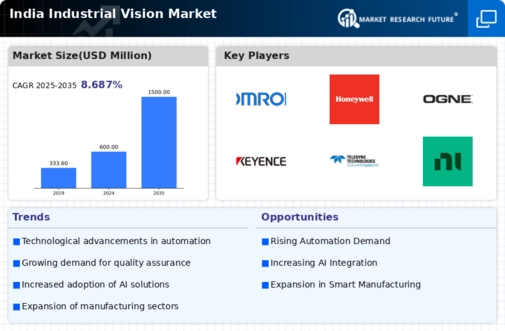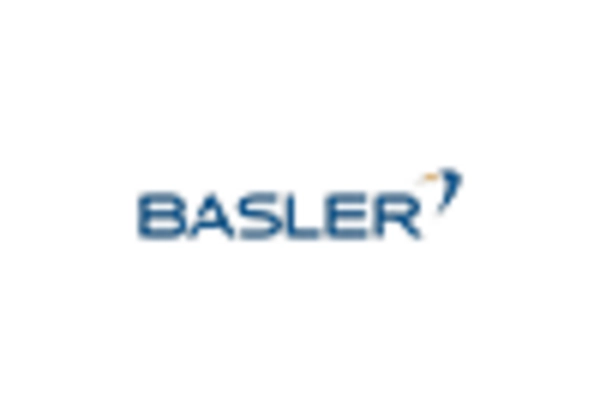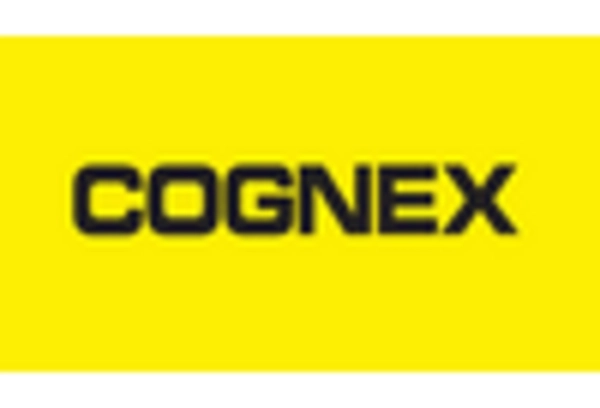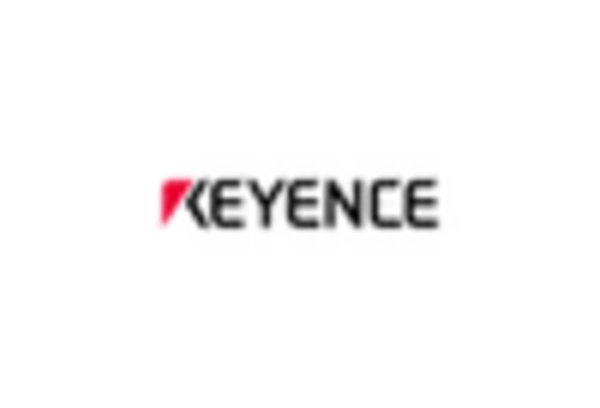Rising Automation in Manufacturing
The industrial vision market in India is experiencing a notable surge due to the increasing automation in manufacturing processes. As industries strive for enhanced efficiency and reduced operational costs, the adoption of automated systems is becoming prevalent. This shift is driven by the need for precision and quality control, which industrial vision systems can provide. According to recent data, the automation sector in India is projected to grow at a CAGR of approximately 15% over the next five years. This growth is likely to propel the demand for industrial vision solutions, as manufacturers seek to integrate advanced imaging technologies to monitor production lines and ensure product quality. Consequently, the industrial vision market is expected to expand significantly, driven by the automation trend that emphasizes the importance of real-time monitoring and defect detection.
Growing Demand for Quality Assurance
Quality assurance remains a critical driver for the industrial vision market in India. As industries face increasing pressure to meet stringent quality standards, the need for reliable inspection systems becomes paramount. Industrial vision systems offer advanced capabilities for defect detection and product verification, which are essential for maintaining quality in production. The market for quality assurance technologies is projected to grow at a rate of 12% annually, reflecting the rising importance of quality control across various sectors, including automotive, pharmaceuticals, and electronics. This trend suggests that manufacturers are increasingly investing in industrial vision solutions to ensure compliance with regulatory standards and enhance customer satisfaction. Consequently, the industrial vision market is likely to see sustained growth as companies prioritize quality assurance in their operational strategies.
Expansion of E-commerce and Retail Sectors
The rapid expansion of e-commerce and retail sectors in India is significantly influencing the industrial vision market. As online shopping continues to gain traction, logistics and warehousing operations are becoming more complex, necessitating the implementation of advanced vision systems for inventory management and order fulfillment. The e-commerce sector is expected to reach $200 billion by 2026, driving demand for efficient sorting and packaging solutions. Industrial vision systems play a crucial role in automating these processes, ensuring accuracy and speed in handling products. This growth in e-commerce is likely to create new opportunities for the industrial vision market, as companies seek to enhance operational efficiency and improve customer experience through technology-driven solutions.
Technological Advancements in Imaging Systems
Technological advancements in imaging systems are a key driver for the industrial vision market in India. Innovations such as high-resolution cameras, 3D imaging, and machine learning algorithms are enhancing the capabilities of industrial vision systems. These advancements enable more accurate and faster inspections, which are essential for modern manufacturing processes. The market for imaging technologies is projected to grow by 10% annually, reflecting the increasing demand for sophisticated vision solutions. As industries adopt these advanced technologies, the industrial vision market is likely to expand, driven by the need for improved efficiency and quality in production. The integration of cutting-edge imaging technologies is expected to redefine the standards of inspection and monitoring in various sectors, further propelling market growth.
Government Initiatives for Smart Manufacturing
The Indian government is actively promoting smart manufacturing initiatives, which is positively impacting the industrial vision market. Programs such as 'Make in India' and 'Digital India' aim to enhance the manufacturing landscape by encouraging the adoption of advanced technologies. These initiatives are likely to foster an environment conducive to the growth of industrial vision systems, as they facilitate the integration of smart technologies into traditional manufacturing processes. The government's focus on increasing manufacturing output to $1 trillion by 2025 indicates a strong commitment to modernizing the sector. As a result, the industrial vision market is expected to benefit from increased investments in automation and quality assurance technologies, aligning with the broader goals of enhancing productivity and competitiveness in the manufacturing sector.

















Leave a Comment